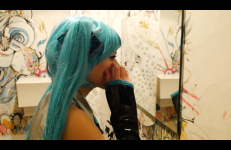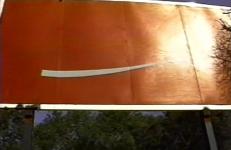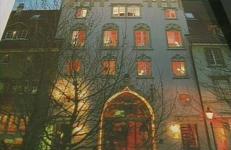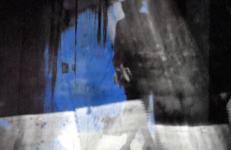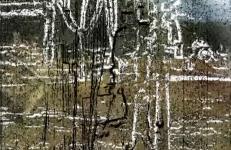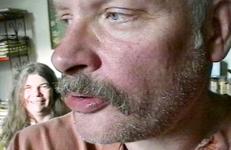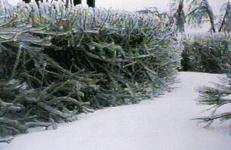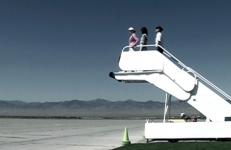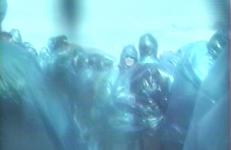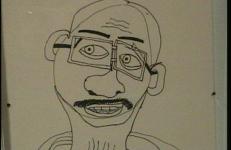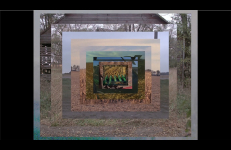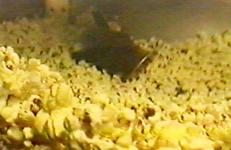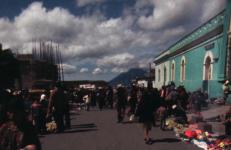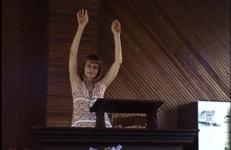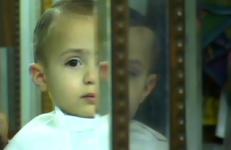The rivers are in flood stage during a scenic tour of Tulsa; while in El Reno, Oklahoma, it's as dry as a two-week old peach cobbler. The locals puff up on breaded catfish while an influx of British visitors seek in vain a vegetarian platter amid the thunder boom and hail clatter.
Expedition/Travel
George is in Tampa, Florida to do a one-day video workshop, so they make a fast-moving trailer for a non-existent UFO abduction movie.
Hatsune Miku is a co-creation platform, personified by a cute and oddly seductive animated character. Fans bring her to life by creating content that she “delivers”. Her entire persona: lyrics, music and animation – is fan created, and that's her charm. Cosplaying Hatsune Miku, Ann Oren goes to Tokyo for a performative journey among these fans and explores the Miku phenomenon as an expression of collective fantasy. The habits of Miku's fans is a familiar exaggeration of our social media habits, that flood us with crowd creativity.
A fragmented, experimental biography of the 19th-century poet and writer Isabelle Eberhardt, whose brief, unusual life ended abruptly in a flash flood in the desert.
A personal essay about connection and disconnection, in and through different realities.
This Is Not Beirut is a personal project that examines the use and production of images and representations of Lebanon and Beirut, both in the West and in Lebanon itself. It also records Salloum’s interactions and experiences while working in Lebanon, focusing on this representational process by a Westernized, foreign-born Lebanese mediator with cultural connections to and baggage from both the West and Lebanon.
As the camera looks out through a barred window and the clock strikes four in a Swiss city, the death of Yasser Arafat provides the starting point for a journey back in time.
Throwing Stones is the third episode in the Hotel Diaries series, a collection of video recordings made in the world’s hotel rooms, which relate personal experiences and reflections to contemporary conflicts in the Middle East.
This is a later reworking of original video documenting the goings-on of the village, Tlocalula, Mexico in 1973.
This is a later reworking of original video documenting the goings-on of the village, Tlocalula, Mexico in 1973. Uses footage from Oaxaca 2004 in the background.
A chaotic assortment of artists tumbles forth in the first half of this video diary, and the pieces of flotsam and jetsam coalesce into the junk statuary of Jerry Barrish, sculptor. Then the piece drifts down to Baltimore where my brother, Mike, and I are invited to the premire of Divine Trash, a documentary on John Waters that is being screened in an old and historic theater prowled by the media and folks in evening attire (evening-out attire).
Trip is inspired by the main oeuvre of architect Raine Karp--the concert hall designed for the city of Tallinn between 1975-1980. Considered the most important building realized in Estonia, Linnahall is a time capsule preserving the utopian ideas of centralized power and of egalitarian modernism, and an example of how architecture can stir public emotions in our times of corporate dominance.
Trip is inspired by the main oeuvre of architect Raine Karp--the concert hall designed for the city of Tallinn between 1975-1980. Considered the most important building realized in Estonia, Linnahall is a time capsule preserving the utopian ideas of centralized power and of egalitarian modernism, and an example of how architecture can stir public emotions in our times of corporate dominance.
They just flew in from New York, and boy, are their arms tired... Out in the Nevada desert, against the windblown backdrop of Air Force bomber training sites, artists Hajoe Moderegger and Franziska Lamprecht — better known as eteam — gathered testimonials of stranded passengers, crew members, and local residents to recall an episode in the lost annals of American aviation: the 2006 "unscheduled layover" at International Airport Montello (IAM). Truth in Transit reaches beyond simple documentation.
Turistas deals with the letdown of a world that is pre-mediated and post-digested—a video travelling guide that updates the 19th century artist's Grand Tour and downgrades it to 21st century not-so-Grand status.
—Maria-Christina Villasenor, Associate Curator of Film and Media Arts, Guggenheim Museum
Frisco anxiously awaits the pyrotechnic birth of a New Year while the remnants of holiday greenery still burn bright in all the right places. One of those places gives shelter to an Abyssinian animal of lethargic nature, while all about her the rumblings of tummies in turmoil foreshadow the gluttony of her bipedal guardian.
A series of portraits either stroked on canvas or snapped on photo emulsions becomes the theme of this travelette as the viewer relives the visions that confronted me during a hop and skip excursion over state lines and bodily curvatures.
A hug/punch eulogy for all things impossible now. Vague Images is a sketch book of images and sounds from the year wrapped around a trip out to Loomis, South Dakota to find the abandoned farm where my grandfather grew up. At the same time the film is a travelogue of my frustrations and understandings of gay sexuality. The two are connected.
One of my weather diary series out in Oklahoma. The tone is wistful, the surroundings wispy (with some puffs of pungency). The TV is on and the porcelain is smeared with some residue atrocity from a previous passion. But all is well as emptiness persists beyond the four walls of this prairie mausoleum.
Alienation in academia beneath the chandeliered opulence of a political correctional facility that caters to clashing cultures with chicken fajitas and carefully worded alphabet soup. Features George at the Flaherty Seminar and the Chicago Underground Film Festival.
A cross-generational binding of three filmmakers seeking alternative possibilities to the power structures they are inherently part of. Each woman extends her reach to a subject she is outside of. Vever grew out of the abandoned film projects of Maya Deren and Barbara Hammer. Shot at the furthest point of a motorcycle trip Hammer took to Guatemala in 1975, and laced through with Deren’s reflections of failure, encounter and initiation in 1950s Haiti.
A vever is a symbolic drawing used in Haitian Voodoo to invoke Loa, or god.
Another edition to my weather diary series, this particular one has more social intercourse occurring in the prairie hovel which houses the hidden longings of he who seeks sustenance from the void. The void acts up in the beginning and then simmers warmly in the glow of companionship from fellow travelers on this Route 66 to who knows where? Perhaps to that pillar of pancake perfection known as Denny's (the restaurant, not the deity).
A trip across the bay to Concord yields a harvest of non-fruit-like beings who celebrate a housewarming that simmers with macho machinations and family discord. The mood is upbeat while the company is lowbrow, and coming out of the bushes rather than the woodwork.
A trip to the Marin headlands at the Golden Gate of San Francisco Bay headlines this video diary. The viewer gets to eves and eye drop on various verbal and real time activities that are of a wet nature now and then. There’re boats and bodies and some spoken unspeakables amid the splendor of natural and unnatural expressions befitting the rim of a pacific paradise at low tide.
We will live to see these things... is a documentary video in five parts about competing visions of an uncertain future. Shot in 2005/06 in Damascus, Syria, the work combines fiction and non-fiction. Each section of the piece--the chronicle of a building in downtown Damascus, an interview with a dissident intellectual, documentation of an equestrian event, the fever dream of a U.S.
We will live to see these things... is a documentary video in five parts about competing visions of an uncertain future. Shot in 2005/06 in Damascus, Syria, the work combines fiction and non-fiction. Each section of the piece--the chronicle of a building in downtown Damascus, an interview with a dissident intellectual, documentation of an equestrian event, the fever dream of a U.S.






